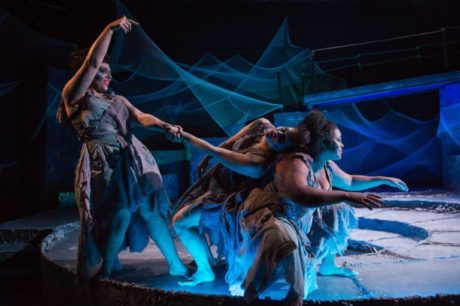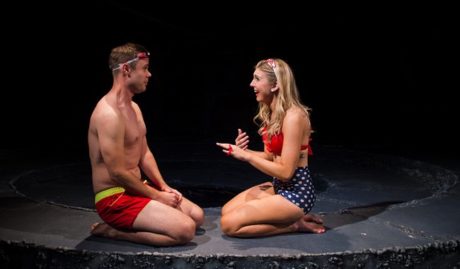This is another of my columns that delves deeper into the technical design aspects of an area live theater production. In this case, it was the intriguing sound design of NextStop’s Eurydice that led me to interview Kenny Neal. In the production of Eurydice, Neal’s music and sounds became another character in the show, at least to me. The sounds and music were potent story-telling tools that furthered Sarah Ruhl’s marvelous modern re-telling of an ages-old Greek myth.
Neal has been busy around town. Over the years, he has worked at many DC area theater companies. In 2016 he received a Helen Hayes Award nomination for his sound design for 1st Stage’s production of Old Wicked Songs.
A fascinated note is that Neal also developed the sound design for The Gulf; which has been playing at Arlington’s Signature Theatre while NextStop’s (Herndon, VA) Eurydice opened in the past few days. While this article is about the Eurydice sound design, my review of The Gulf included that Neal’s work was a “resplendent underpinning”
David: Why did you want to develop the sound design for the NextStop production of Sarah Ruhl’s Eurydice?

Kenny: Eurydice presents a fantastic world-building opportunity for a theatre designer. The script is specific only in what is essential to the story, which means the director and design team can really explore bold ideas and concepts. “You know what I’ve always wanted to do?” was a common theme of our production meetings. That level of creative freedom is as exciting as it is rare.
How did you prepare to develop the Eurydice sound design?
Director Jay D. Brock and I met to talk about how we like to work and the types of storytellers we each are. I showed up to our first meeting with six pages of notes and ideas before I even knew I had the job! We spent several weeks before rehearsals began exploring design ideas, both one-on-one and with the entire production team. Jay would send me rehearsal video of important moments so I could be thinking about how sound could support them. Having insight into what the set, lights, costumes, props, and movement designers were thinking helped me decide how to create the sonic world that is presented in Eurydice.
Was the sound design for Eurydice “created” or “found”? Is the sound design a continuous loop or are there sound cues, and if so, how manysound cues are tere?
Eurydice gave me the chance to draw inspiration from musical influences I’ve always wanted to use. I’m a music composition nerd and am a big fan of the early electronic and noise music that came out of the Columbia-Princeton Electronic Music Center in the 1950s and 1960s by composers like Vladimir Ussachevsky, Milton Babbitt, and Mario Davidovsky.
I’m also crazy about the music of contemporary composers like Krzysztof Penderecki, George Crumb, György Ligeti, Oliver Messiaen, and Arvo Pärt. Some of their music is used to great effect in movies like The Shining and The Exorcist, and while the underworld in Eurydice is not meant to be scary or menacing, I felt this type of music could be extremely effective in helping to create a sonic texture that would be both unfamiliar and arresting.
I drew upon elements of both genres, mixing in my own contributions to create a densely layered soundscape that is present in some form throughout the entire play. Birds are represented by atonal flute passages; Eurydice’s fall into the underworld is represented by a cacophony of percussion and a wave of white noise; the arrival of The Lord of the Underworld is announced by ridiculously deafening fanfares of speed metal. There are about 200 sound cues in Eurydice, and most are comprised of multiple individual sound elements. For example, the cue for the final entrance of The Lord of the Underworld is a mix of about fifteen individual sounds of cymbals, piano strings and distorted guitar power chords!
In addition to the musical elements, there are extensive traditional sound effects mixed in as well. Dense layers of water drips create a sonic depth to the underworld; sounds of boulders scraping together enhance the movements of The Stones; deep subsonic frequencies shake the theatre seats; environmental sounds of wind and rain are employed at important moments in the story.

How would you describe your Eurydice sound design?
My design for Eurydice can best be described as a complete environment; if this were performed as a radio play, you would know where the characters are by what you hear. At least that’s what I hope I achieved!
Tell me more about the collaboration with Director Jay D. Brock and the cast to develop the Eurydice sound design?
One of the first decisions was that it would be a mistake to try to literally represent the music of Orpheus, the “world’s greatest musician.” Leveraging the audience’s imagination is the only way to approach such a subjective aesthetic. So the “Symphony for 12 Instruments” became an abstract concept using textural and atonal musical ideas. Another was to expand upon the specific musical references Sarah Ruhl makes in her script, such as Father teaching Eurydice the song “I Got Rhythm.”
I saw this as an opportunity to mirror the relationship she has with Orpheus. So the melody Orpheus tries to teach Eurydice in the first scene became a musical inversion of the four-note Gershwin melody Father teaches her in the underworld. When Orpheus “sings” to open the gate to the underworld, the tone cluster we hear is comprised of these same four notes. I seeded a theme played on chimes in moments that highlight the bond between Eurydice and her Father throughout the play. This sound becomes an important and heartbreaking element in the last moments of the play. I want my design to be consistent and have an internal logic that follows rules that make sense in the play. I think that pays off on both a conscious and subconscious level. These types of musical connections are extremely important to me.

Why is the Eurydice pre-show music important?
The pre-show soundscape is always the last element I add in the tech rehearsal process, as I want to be sure it both comments on and complements the complete design of the show, which can evolve as we move closer to opening. In most theaters, particularly NextStop, the audience enters the space and immediately experiences elements of the world of the story when they see the set. What they hear can be just as important in creating that first impression. I carried the textural ambient sounds from the underworld into the pre-show to help immerse the audience from the moment they walk in. At the top of the show, a flurry of discordant strings (string being a very key element of the play) helps us rise up out of the literal darkness and into the sunny beach of the first scene between Orpheus and Eurydice.
Thank you for this opportunity to share some of the thought and process that goes into creating a sound design! I feel it’s an incredibly powerful storytelling medium, and I’m proud of the work I was able to do on Eurydice..
Running Time: 90 minutes, with no intermission.
Eurydice plays through November 20, 2016 at NextStop Theatre Company – 269 Sunset Park Drive, in Herndon VA. For tickets, call the box office at (866) 811-4111, or purchase them online.





